And now, at this point (day 30) in this particular residency in Beatty, Nevada, I am pondering a conundrum about my own landscape work. I haven’t quite enough distance to say for certain [pun recognized after it was made] but it seems to me that my interest in context and a sense of place interferes with my achieving a stylistic breakthrough, particularly with the set pieces that I love, like the mountains around Beatty.
As my colleague and friend David T would say: if he walked into a gallery with my landscape paintings, he wouldn’t think of them as being “by June Underwood,”just as “nice” (not a compliment) landscape paintings.
There are models for moving beyond the “mere landscape”, of course: Grant Wood’s landscapes and Lawren Harris in the Canadian Group of Seven; perhaps Arthur Dove; maybe Hopper would be helpful. Rackstraw Downes is a kind of heroic figure to me and he and David Hockney represent a form of seeing that I believe in. Hockney’s desert road (Plum Blossom Road or some such name) is a masterpiece of getting an angle that makes sense (angles, I should say); and Downe’s work in Texas — his five-part series — are also inspirational. I rather like the jaggedy edgings of Hockney’s collaged landscapes, but I admire immensely Downes’ refusal to avoid what is there, whatever is there.
David T (my friendly colleague) and the abstract landscape painters who are just on the other side of the continuum of representational through abstract make interesting, but spiky, paintings. For the life of me, I can’t seem get my painting around that kind of corner. I want to put my personal spin on landscape. I have done so with my wacky urban-scapes. But my sense of gratitude about place, about my love of what is in front of me, all that interferes, in my landscapes, with an internal sense of — or expression of — self.
Rhyolite Ghost Town and the Goldwell Open Air Museum, Oil on board, 18 x 36″
So I pursue the conundrum: how can my sense of place wrap itself around a place that has a strong sense of its self — immoveable mountains, rocks that are what they are, landscapes that change only according to the time of day and the time of year and the temperament of sky and do not respond to my little self. So I continue the questioning.
What is it that might call to me in this landscape, this sense of place, that could be translated into a personal style? The colors, of course, but they tend toward the conventional — lots of landscape artists jack up the color in order, I suspect, to try to make something their own. I would say I’m not jacking up the colors as I am painting, but later, the colors seem pushed hard.
Bare Mountains, pm, oil on board, 12 x 16″
The shapes and forms here are phenomenal, particularly as you go into California’s Death Valley on the “Beatty Cut-off” from the Nevada town of Beatty . I am interested in the intersections of geology and painting — the fan-shaped alluvials, the fault scarps, the up-lifting and down-tilting, the intersections of faults and washes, the washes that join into the wine-glass formations, cutting deeply into the hillside. I can see them; I just saw them. They are gashes, and up close they are canyons, formidable, unyielding except to wild rushes of water such as I doubt I will ever see. The shapes that pile up on one another in different colors are wonderful to see; the rocks, some rounded, some sharpened, some cut through with various mineral veins; and those amazing desolate playa, rocky plains, where almost nothing grows except rock. Truly rock gardens, although garden represents something too tame to be accurate here. Immense flats of basketball sized jagged rocks set within smaller ones. On and on and on. A vision of a sort of beautiful hell.
I wondered if I cropped out the sky, thus losing the urgency of the landscape format, if that would enable me to see and paint differently. Or if I sketched without including the edges of mountains, the contours by which we judge our surrounds.
Here’s a cropped version of some of the formations in an area of the park called Artist Palette:

Below is a naturally cropped (ie with the camera rather than photoshop) version:
 And finally, here’s one with the sky:
And finally, here’s one with the sky:

This last also has the classic, into-the-photo road, which brings it totally into the conventions of landscape work. Here’s my first plein air version of another similar place, equally formed by geologic processes, equally astonishing.
Golden Canyon 1, 18 x 24″, oil on board
A photo of the entrance to this path looks something like this:
[Mindy Hill Minds my gear while I carry the painting above back to the car.]
So the question remains whether I have any way to imprint myself on my paintings of the landscape, or if they will remain mere simulcrums of something far grander. I begin to see why the Abstract Expressionists refused realism altogether. It was altogether too much to gather together.
….an addendum to the above, written on day 31: this week, I took two large pieces of canvas, unstretched, and taped them to the walls of the Red Barn Studio. And I began two non-plein air, only slightly connected to reality, landscapes. Neither of them is finished (and the photos are dreadful because of the glare). But they give me some hope that while I can’t match the landscape, that I can make some paintings that might evoke something of its feel. I think I would have to go larger (and be younger) to do what really I think of doing. But at least 5′ x 5′ escapes the smaller picture planes and forces me to think and act big. In going larger, I am forced to use different tools and to be clear about what it was that I want to portray. There isn’t much “out there” to guide me; it has to come from within.
…a second addendum, written on day 33, Saturday. Yesterday, I think I broke through some kind of barrier. I finished (or somewhat finished) four paintings. One was of a stripped mountain, mined for gold, which I had done previously and was very unhappy with. Here is its latest incarnation;
Bullfrog Barrick Open Pit Mine, Oil on board 18 x 36″
I finished that one on Friday, and begain and finished the plein air below, sitting at the door of the Red Barn Studio from which I’m working:
Amargosa Playa 3, Oil on board, 18 x 24″
And finally, the big canvases, taped to the walls, which seemed so impossible on Thursday, got reworked into some kind of clarity on Friday.
Amargosa Playa 2, Oil on canvas, about 5′ x 5′
Golden Canyon Revisited, Oil on Canvas, about 5′ x 5′
Here’s a detail of Golden Canyon Revisited:
The two big paintings are nearly complete and won’t be touched again until I return to Portland, about April 3. I counting on the desert air to dry them enough that they can be rolled and put into the Honda for the trip.
So, I admire Birgit’s painting, which comes from within; and I admire Hanneke’s, which are so clearly from the object itself. I want to find a way to integrate the without — the sense of place — with the “within” my own subjective exhilaration or despair or fear in facing a specific “place.” Landscapes that simulate reality are not, for me, adequate. But the process is uncertain, the results uneven. One day I think I’m a total failure and the next makes the process seem inevitably OK.
I don’t think I’m alone in this, but I guess I have to ask — anyone else have these kinds of ups and downs? How do you process them.
I ran across this quote from Rackstraw Downes — it seems an appropriate way to finish:
A professional artist’s life is uncertain and miserable and everyday you feel obliged to do something extraordinary and unusual. It has its problems, it really does. The vagaries of fashion whisk you in and whisk you out again, and give you an income and take it away again. I will say this though, that all of us that are painters or poets or whatever spend quite a big chunk of time everyday doing exactly the thing we really want to do. And that can’t be said by lots of people.
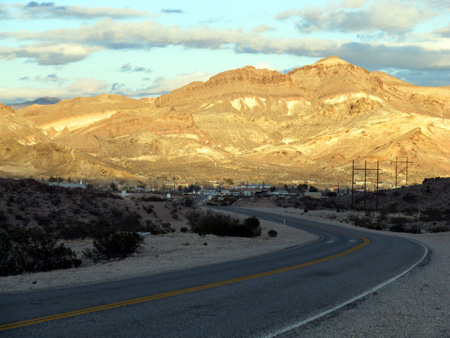


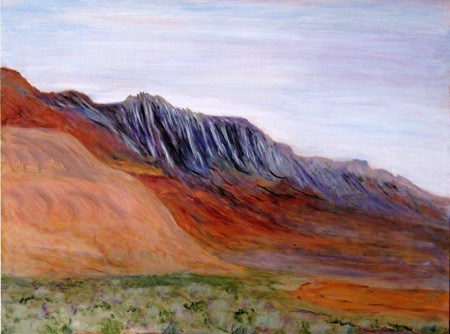

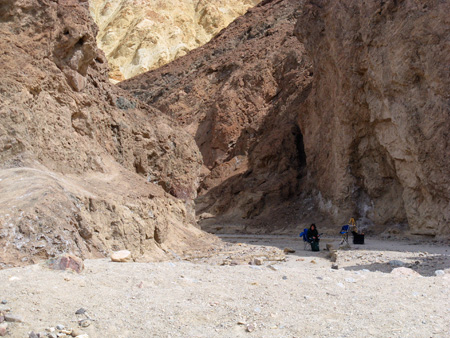
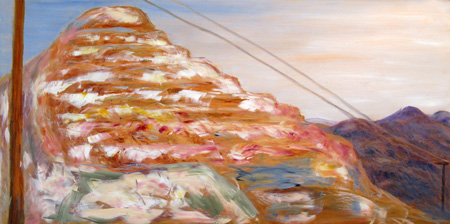

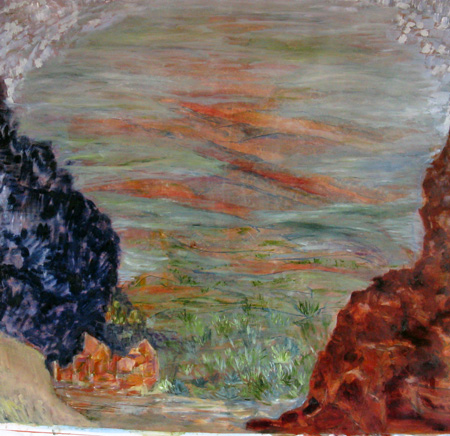
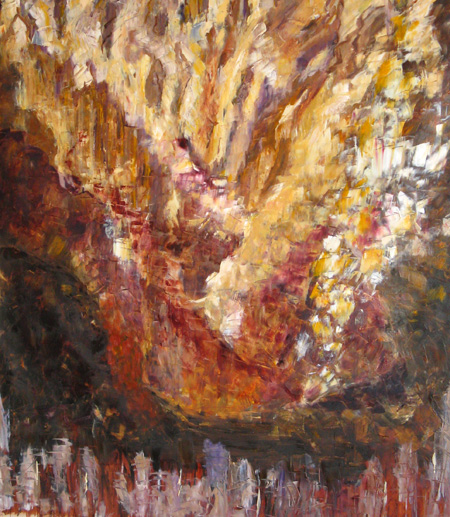
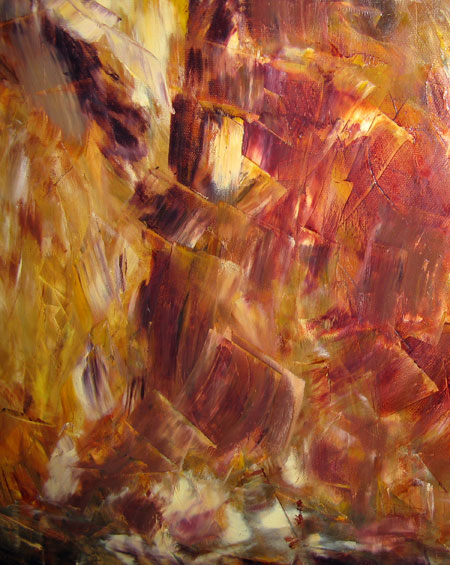

June,
I love the Nature that you did from memory. And I do hope that you can carry that memory with you to Portland and continue there.
I prefer mountains without the scar of a road.
June,
Nice landscape paintings.
Ha ha, just kidding. I mean, they are nice, but, well you know what I mean.
I’m just checking in here, because it’s late and I haven’t fully interpreted the post, but regarding this:
it seems to me that my interest in context and a sense of place interferes with my achieving a stylistic breakthrough
I would say, stylistic breakthrough comes through dedication to what you care about. If the context and sense of place is the thing, you need to accept that and work with it, it seems to me. Let’s not confuse gimmick fake imitation style with the real thing. Real style is a personal way of interpreting something you care about. Fake style is something that becomes an end in itself, not a means. I guess if style in and of itself is what you care about, well, then things might get more complicated.
Rhyolite Ghost Town and the Goldwell Open Air Museum, Oil on board, 18 x 36?
I like this one with the river of a road. Don’t listen to Birgit. A road is a divine sort of gift to a landscape painter because it helps define depth. Imagine deleting all of van Gogh’s roads, Monet’s roads, etc.
Sure I more easily sense the JUism in your terrific Urbanscapes but only because the wackiness is more obvious with your curious handling of human proportions and the hard edge perspective of architecture; I suggest just keep working because the results are fabulous. The Ups and Downs are Always and for Everyone.
With all due respect to David T, he’s wrong. Perhaps he doesn’t spend enough time out of the city? Your landscapes are not only distinctive (test me!), but expressive of your passion for the geology. I think you’re best in the west, where you show the muscle and sinew of the land laid open like–pardon the analogy–a flayed but living body. Compare the body diagram here (from kidshealth.org)
with most of your paintings in this post (Amargosa playa is different–the exception proving the rule).
Even more obvious in your Goose Rock or John Day beds:
This interpretation is interesting to compare with Wanda Corn on Grant Wood at one o0f your links. His smooth, rounded forms are all about the outer morphology of the body. By contrast, when you’re back East and doing green-clothed hills, you’re clearly concerned with bone structure.
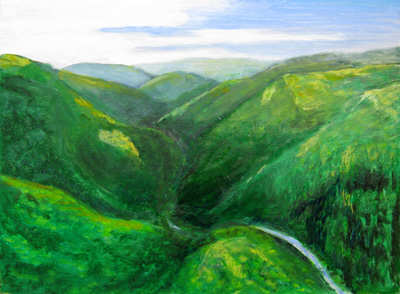
Birgit,
Thank you for the kind comments.
My experience is that the “memory” of a place, even one as strong as this, fades after about a month for me. It becomes useless to think about painting from the place once the fade has set in.
This is not to say that I think that all this space and looking and painting hasn’t had any effect on me. But after a month, I lose any sense of a direct contact with it. So back in Portland, I’ll probably return to the cramped and somewhat silly sense of the city, which has its own charm, of course.
Karl,
I perhaps mis-used or carelessly used the word “style.” It isn’t a stylistic achievement, in any casual sense, that I’m looking for in my work so much as an imprinting of what I’m seeing/feeling on the landscape. D. said of one of my paintings (in the city, as it happens) that it had the feeling of “thereness”. I paraphrase, but closely, I think. It’s that “thereness” that I want to capture, a thereness that is personal but can be read by others, also.
The distancing and framing that happens when you try to capture the vast space also tends to turn the picture into a mere picture, a pretty sight. It’s hard to achieve a felt sense of space and solid rock from a distance without it being just another snapshot of a painting.
So it isn’t “style” that I’m concerned about, although I used the word. It’s capturing my sense of the space, which will inevitably be very different from yours, or D.’s, or Birgit’s, or Steve’s, or Jay’s.
I once wrote an essay in which I tried to describe how the pioneers would have viewed the land they were thinking of settling in. The men would be looking at it for farming properties or logging potential or cattle grazing space. The women would be looking for a snug place for shelter, out of the wind and sun, perhaps, and nearness to water for cooking. The two genders would have entirely different visions of what they looked at. And specific members of a gender would have his or her own set of seeing — a desert aster, a hole signifying some kind of living creature. It’s that sense of what a person sees, and sees differently because of their interests, history, eyesight, exposure, knowledge base, etc. that I’m calling a personal “style.”
I don’t know if that’s making any sense. Thank you for the comment about Rhyolite (as well as for making me try to clarify my language). It’s one of my favorites. It was done plein air, sitting on that river of a road (there’s not a lot of traffic to Rhyolite). It is specific to my experience, because there’s only one place on the road where you can see how the mountains contain those bits and pieces of ghost town and Open Air Museum. Jer never sees it because he’s driving and making sure the car doesn’t leave the road. Others drive the road fast, or are looking for mine openings, or old house foundations, or rattlesnakes, or whatever. So that sense of the town as snugged into the 3-sided bowl of mountains fits something of what I believe about the history of the place — that it was chosen partly because it gave a sense of shelter. And that it contains just the detritus of its history still. Even the art is just another piece of the rocky surface. It’s both history — that we come to detritus in the end, regardless of our stature in the middle, but that we choose, in the middle, that which can enhance our views and also make us feel safe. Ta-da, I blather.
Thanks for taking the time to comment.
This kind of “thinking” (more like “sensing”) of the place I’m confronted with is what I’m hoping to capture through my “style.”
And thank you, D. for the encouragement. It sounded a blog or two ago as if you were having your own version of ups and downs.
This blog about “style” really is a product of a week’s maunderings, ponderings which changed radically as the week developed. Wednesday I thought I was on the right track. Thursday night I was in despair (Jer pointed out a possibly fatal flaw in one of the big canvases just before we left the Studio, and once I saw it, I knew I had to fix it but didn’t know how). By Friday evening, I was almost manic with delight, having fixed a couple bad pieces and moved a couple of others into new space. So this blog really is about process.
Keep on working, indeed!
Steve,
As usual, you are astute (and kind!)
It _is_ the muscle and sinew that I’m interested in, although as with the word “style” I might have a peculiar take on the meaning of the words. I need to have a feel for the history, the geology, a feel for the place itself, its underpinnings, if you will, in order to do any kind of real painting about it. And then the painting also informs me about the place, so it adds to my knowledge, which then builds further on it.
Jer and I spend an enormous amount of time reading everything we can find about the places we inhabit, even if we are only there for a month or so. It’s what makes the inhabiting both tolerable and exhilarating.
I can’t keep the geology in my brain, but Jer’s help, some of it sticks. The human history is easier — painting Rhyolite and Beatty, one a ghost town, the other a desert gas stop — made me see clearly that they both were founded where the hills could surround and hold them. Part of that was due to circumstance (where gold was found, where water is located) but part of it, I believe, is the unconscious human desire for locating ourselves where we can understand the space, where it has edges and shapes that we can take in.
The John Day paintings of landscape are of geological formations outside of human decision making, but far more informed (for me) by the geology, which I had worked hard to get a grasp of. The eastern Oregon geology is a mere 65 million or so years old (post-dinosaur) and has been extensively surveyed and worked and understood and written about by the paleontologists with whom I was associating. So _my_ understanding, my seeing of the space, was more informed by geology there than of history. In Basin (Montana) I was working on the immediacy of the place, its “thereness” as it presented itself at 15 degrees above zero and at 6000 feet above sea level where people and dogs existed peacefully. Those are more urban-scapes than any I’ve done here in Beatty, but they were definitely informed by the history and understanding I had of the town — its mine tailings and Interstate-highway dealings, its masonic temples and interactions of various moralities — its bones and sinews.
So I think you are right, although I hope not to flay in my paintings too much. It’s hard not to do — the Bullfrog Barrick Open Pit Mine might deserve a bit of flaying. And there are some paintings of places around Beatty that I might do in the coming week that the Chamber of Commerce would not approve of — we’ll see.
Thanks for the insights. This (I’m including all the comments that have been made) has been a really helpful exchange for me.
Hi June,
I found a post that I think is relevant: How to find a style — Cennino’s take.
Short story shorter: if you try to work with all sorts of styles one after the other, you will have trouble finding one of your own. Cennino said it better, it’s worth a look.
It seems to me Cennino does say to work with all sorts of styles (“if you are in a place where many good masters have been, so much the better for you”), but just take plenty of time on each one. How much help is that? :-)
In my own development–and I feel I’m in a similar place as June, not confident or settled in a “personal style”–I’ve found it helpful to study and learn about various artists and how they’ve approached their work. Without actually attempting to copy anyone’s style, I inevitably get lots of ideas of things I want to do myself, whether technical notions or ways of thinking about something. As I try different things from this whole mish-mash, I eventually find I am doing something nobody else quite is (to my knowledge), despite owing plenty to many others. I’m not at all sure the process ever ends, which is probably a good thing.
I’d made a long reply about your comments on wanting a ‘stylistic breakthrough’ and lost it…so…very briefly…I think stylistic breakthroughs come when you’re not looking for them. They come when there is a problem you’re struggling to solve…often a simple problem about representation…which takes all your conscious attention and allows something else…unbidden…to creep or crawl into the work. Downes is a prime example..he makes stunning pieces by simply trying to get the drawing and light and the color …right. This of course requires some very inventive tactics, and trials and errors, to find the ranges of color and distortions of shapes and relative contrast of parts which invoke, for him, some relation to what he sees.
At the other end of the scale is someone like Peter Doig, whose landscapes are veiled dreamlike narratives……or,Bonnard or Matisse, who make their own visionary worlds from fragments of the look of this one.
I’m new to blogging and know this sounds a bit…pretentious? Gotta practice somewhere…need to find a voice.
Your idea of the cropped mountains seems promising; to make the geology and structure, and the close range of color there, the primary concern. In the images above the detail of Golden Canyon has a much punchier sense of structure and variety than the whole painting….you might look for that play of rigid geometry against the soft eroded areas…The detail seems crystalline.
Bruce,
I also like the canyon detail especially well, but I wonder if it isn’t because of the lush detail we can see so much better than in the full picture, given the image size. I’d love to see the full painting in life. Your mention of “crystalline” makes me think facet which recalls an essay on cubism (by Walter Darby Bannard) about its essence being the construction of a work from combination of discrete similar elements, such as these knife marks. They even have a gradation like Cezanne’s facets.
You have a wonderful voice, thanks for the comment.
I think I’ll read the posts here often; they seem to be about specific painting issues, and are comprehensible!! So much criticism is vague and opaque.
Thanks for the encouragement!
Bruce.
Thanks, Bruce and Steve,
Bruce, you don’t sound pretentious at all — like the reset of us you sound like you are searching for — well, for whatever is worth searching for at this time of your existence. Steve reminded us of Wechsler’s Seeing is forgetting the Name of the Thing One Sees, about Robert Irwin. Did I mention that? I’m trying to collect contemporary artists/writers who see things with less input from learned brain synapses, as it were.
Steve, the crystalline structure is a good observation. The best painting (qua painting) that I did was almost the opposite of Golden Canyon Revisited (I don’t think I showed it on any posts) — looked like a Lawren Harris (the Canadian group of Seven — I hope I have the name right). Quite different from this. It was painted plein air from the top of the formation that the “Golden Canyon Revisited (the abstract) was at the bottom of.
Don’t know if that is making sense. I’m still a bit out of it, so sense isn’t always as strong as I’d like it to be. I’ve been ill most of the month, so it’s harder to get my mind — not to mention my urls and spelling — to work.